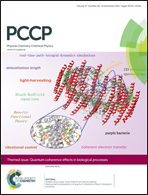Magnetism in olivine-type LiCo1−xFexPO4 cathode materials: bridging theory and experiment†
Abstract
In the current paper, we present a non-aqueous sol–gel synthesis of olivine type LiCo1−xFexPO4 compounds (x = 0.00, 0.25, 0.50, 0.75, 1.00). The magnetic properties of the olivines are measured experimentally and calculated using first-principles theory. Specifically, the electronic and magnetic properties are studied in detail with standard density functional theory (DFT), as well as by including spin–orbit coupling (SOC), which couples the spin to the crystal structure. We find that the Co2+ ions exhibit strong orbital moment in the pure LiCoPO4 system, which is partially quenched upon substitution of Co2+ by Fe2+. Interestingly, we also observe a non-negligible orbital moment on the Fe2+ ion. We underscore that the inclusion of SOC in the calculations is essential to obtain qualitative agreement with the observed effective magnetic moments. Additionally, Wannier functions were used to understand the experimentally observed rising trend in the Néel temperature, which is directly related to the magnetic exchange interaction paths in the materials. We suggest that out of layer M–O–P–O–M magnetic interactions (J⊥) are present in the studied materials. The current findings shed light on important differences observed in the electrochemistry of the cathode material LiCoPO4 compared to the already mature olivine material LiFePO4.


 Please wait while we load your content...
Please wait while we load your content...